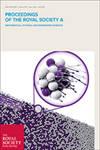Flow and deformation in poroelastic media with moderate load and weak inertia
Proceedings of the Royal Society of London. Series A. Mathematical and Physical Sciences
Pub Date : 2004-07-08
DOI:10.1098/rspa.2003.1250
引用次数: 7
Abstract
The governing equations for the deformation and the fluid flow in a poroelastic medium are derived under (i) a moderately small ratio of external load to elastic stiffness which is of O(ε), where ε = l/l′ is the ratio of the microscale to the macroscale lengths, and (ii) a moderately small pore- (or grain-) size-based Reynolds number which is of O(ε1/2), by employing the theory of homogenization. The macroscale governing equations are nonlinear in general and several canonical boundary–value problems are defined in a unit cell with a periodic structure on the microscale. However, to determine the effects of inertia and deformation on the macroscale seepage flow, only a few cell problems need to be solved. The correction to Darcy's law in deformable media is shown to be cubic in the seepage velocity as in the case of a rigid medium but with modified permeability and inertial effect due to deformation. It is also shown that Darcy's law is stated with permeability which is dependent on the state of elastic strain of the medium throughout the consolidation process. While the changes due to fluid inertia and medium deformation are small but as important as the inertial effects in rigid media, the porosity and permeability changes for a medium isotropic on the macroscale are shown to be linearly proportional to the volume strain of the medium, and also modify the inertial effect in Darcy's law accordingly, as compared with the case for a rigid medium.中等载荷弱惯性孔隙弹性介质的流动与变形
采用均匀化理论,推导了在中等大小的外载荷与弹性刚度之比为0 (ε),其中ε = l/l′为微观尺度与宏观尺度长度之比,中等大小的孔隙(或颗粒)雷诺数为0 (ε1/2)的条件下,孔隙弹性介质中变形和流体流动的控制方程。宏观控制方程一般是非线性的,在微观尺度上定义了具有周期结构的单元胞中的几个典型边值问题。然而,要确定惯性和变形对宏观尺度渗流的影响,只需要解决几个单元问题。在可变形介质中,达西定律的修正在渗流速度上与在刚性介质中一样是三次的,但由于变形而改变了渗透率和惯性效应。在整个固结过程中,渗透率取决于介质的弹性应变状态。虽然流体惯性和介质变形引起的变化很小,但与刚性介质中的惯性效应一样重要,但与刚性介质相比,各向同性介质在宏观尺度上的孔隙度和渗透率变化与介质的体积应变呈线性正比,并且也相应地修正了达西定律中的惯性效应。
本文章由计算机程序翻译,如有差异,请以英文原文为准。
求助全文
约1分钟内获得全文
求助全文
来源期刊
自引率
0.00%
发文量
0
期刊介绍:
Proceedings A publishes articles across the chemical, computational, Earth, engineering, mathematical, and physical sciences. The articles published are high-quality, original, fundamental articles of interest to a wide range of scientists, and often have long citation half-lives. As well as established disciplines, we encourage emerging and interdisciplinary areas.

 求助内容:
求助内容: 应助结果提醒方式:
应助结果提醒方式:


